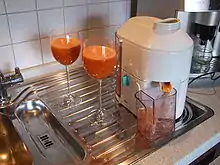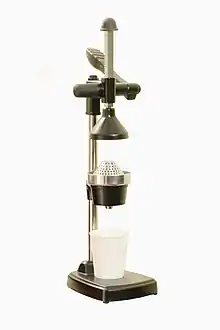Juicing
Juicing is the process of extracting juice from plant tissues such as fruit or vegetables.


.jpg.webp)
Overview
There are many methods of juicing, from squeezing fruit by hand to wide-scale extraction with industrial equipment. Juicing is generally the preferred method of consuming large amounts of produce quickly and is often completed with a household appliance called a juicer, which may be as simple as a cone upon which fruit is mashed or as sophisticated as a variable-speed, motor-driven device. It may also refer to the act of extracting and then drinking juice or those who extract the juice.
Juicing is different from buying juice in the supermarket because it focuses on fresh pressed fruits and vegetables. Residential juicing is often practiced for dietary reasons or as a form of alternative medicine. Becoming first popular in the early 1970s, interest in juicing has since increased. Films such as Fat, Sick and Nearly Dead, Food Matters, and Hungry for Change have increased the sales of juicers.[1]
In America, juicing was popularized by Gayelord Hauser, Jay Kordich and Norman W. Walker.[2][3][4]
Methods
Juicing tools have been used throughout history. Manual devices include barrel-shaped presses, hand-operated grinders, and inverted cones upon which fruit is mashed and twisted. Modern juicers are powered by electric motors generating from 200 to 1000 or more watts. There are several types of electric juicers: masticating, centrifugal, and triturating juicers. These variations are defined by the means of extracting the juice.
- Masticating (also referred to as cold pressed[5]) – utilizes a single gear driven by a motor; slower operation; kneads and grinds items placed in a chute
- Centrifugal – (also referred to as high-speed juicing) – utilizes a spinning blade that resembles a grated basket; faster operation; quickly grinds items and discards pulp in a receptacle
- Triturating – utilizes twin gears; slower operation; often has multiple uses
Health effects
Longitudinal prospective cohort studies conducted at Harvard showed an increased risk of Type 2 diabetes when fruit juice is consumed. Comparatively, consuming whole fruits significantly reduced the risk, suggesting that juicing process may not be beneficial to prevent diabetes.[6] Similarly, consumption of whole apples helped lower cholesterol levels, while clear apple juice did not have such an effect.[7]
The American Journal of Public Health proposed that the Healthy Hunger-Free Kids Act of 2010 in the United States eliminate 100% fruit juices since it has been linked to childhood obesity, and substitute instead with whole fruits.[8]
Juicing removes the fiber content of the fruit or vegetable, and the full benefits of the plant is thus not experienced.[7] Re-adding fiber to the juice cannot be equated to whole fruits.[8] There is a loss in non-extracted polyphenols, a class of phytonutrients, in fruit juice compared to whole plant foods.[9] Most polyphenols are bound to the plant fibers, and constitute the major portion of dietary polyphenols.[10] There is therefore a marked loss of phytonutrients in consuming fruits and vegetables through the juicing process alone.[11]
The American Cancer Society says, "there is no convincing scientific evidence that extracted juices are healthier than whole foods".[12]
Juicing may not be the best way to extract all of the nutritional value from fruits and vegetables. According to Uckoo, when juiced grapefruit was compared with blended, the latter was superior.[13] Smoothies, which are the blending of fruit into juice, not the extraction, leave pulp and seeds within the drink leading to better nutrition.[14]
See also
References
- Claire Reilly (November 29, 2011). "Give it some juice: Breville doubles juicer sales following health doco". Current.com.au. Archived from the original on September 1, 2012.
- Barrett, Stephen; Herbert, Victor. (1994). The Vitamin Pushers: How the "Health Food" Industry is Selling America a Bill of Goods. Prometheus Books. pp. 161-162. ISBN 0-87975-909-7
- Laskow, Sarah. (2014). "The Man Who First Juiced" Archived 2020-01-02 at the Wayback Machine. The Atlantic. Retrieved January 2, 2020.
- Shoshi Parks. (2018). "American women’s obsession with being thin began with this ‘scientist’" Archived 2020-10-24 at the Wayback Machine. Timeline.com. Retrieved January 2, 2020.
- "Cold Press vs. Traditional: Which Juicer Should You Buy?". Huffington Post. February 8, 2013. Archived from the original on October 4, 2017. Retrieved July 28, 2014.
- Muraki, Isao; Imamura, Fumiaki; Manson, Joann E.; Hu, Frank B.; Willett, Walter C.; van Dam, Rob M.; Sun, Qi (2013-01-01). "Fruit consumption and risk of type 2 diabetes: results from three prospective longitudinal cohort studies". BMJ (Clinical Research Ed.). 347: f5001. doi:10.1136/bmj.f5001. ISSN 1756-1833. PMC 3978819. PMID 23990623.
- Ravn-Haren, Gitte; Dragsted, Lars O.; Buch-Andersen, Tine; Jensen, Eva N.; Jensen, Runa I.; Németh-Balogh, Mária; Paulovicsová, Brigita; Bergström, Anders; Wilcks, Andrea (2013-12-01). "Intake of whole apples or clear apple juice has contrasting effects on plasma lipids in healthy volunteers". European Journal of Nutrition. 52 (8): 1875–1889. doi:10.1007/s00394-012-0489-z. ISSN 1436-6215. PMID 23271615. S2CID 206968425.
- Wojcicki, Janet M.; Heyman, Melvin B. (2012-09-01). "Reducing childhood obesity by eliminating 100% fruit juice". American Journal of Public Health. 102 (9): 1630–1633. doi:10.2105/AJPH.2012.300719. ISSN 1541-0048. PMC 3482038. PMID 22813423.
- Bravo, Laura; Abia, Rocio; Saura-Calixto, Fulgencio (2002-05-01). "Polyphenols as dietary fiber associated compounds. Comparative study on in vivo and in vitro properties". Journal of Agricultural and Food Chemistry. 42 (7): 1481–1487. doi:10.1021/jf00043a017.
- Arranz, Sara; Silván, Jose Manuel; Saura-Calixto, Fulgencio (2010-11-01). "Nonextractable polyphenols, usually ignored, are the major part of dietary polyphenols: a study on the Spanish diet". Molecular Nutrition & Food Research. 54 (11): 1646–1658. doi:10.1002/mnfr.200900580. hdl:10261/50305. ISSN 1613-4133. PMID 20540148.
- Saura-Calixto, Fulgencio (2012-11-14). "Concept and health-related properties of nonextractable polyphenols: the missing dietary polyphenols". Journal of Agricultural and Food Chemistry. 60 (45): 11195–11200. doi:10.1021/jf303758j. hdl:10261/77921. ISSN 1520-5118. PMID 23095074.
- "Juicing". American Cancer Society. November 2008. Archived from the original on April 28, 2015. Retrieved August 31, 2013.
- Uckoo, R. M.; Jayaprakasha, G. K.; Balasubramaniam, V. M.; Patil, B. S. (2012). "Grapefruit (Citrus paradisi Macfad) Phytochemicals Composition Is Modulated by Household Processing Techniques". Journal of Food Science. 77 (9): C921–C926. doi:10.1111/j.1750-3841.2012.02865.x. PMID 22957912.
- Ruxton, C. H. S. (2008). "Smoothies: One Portion Or Two?". Nutrition Bulletin. 33 (2): 129–132. doi:10.1111/j.1467-3010.2008.00696.x.
